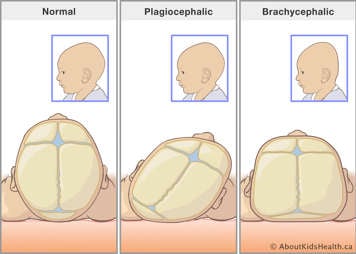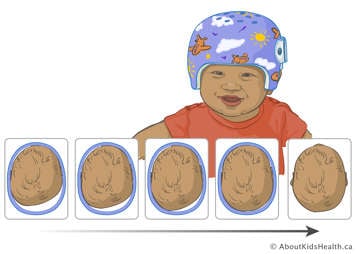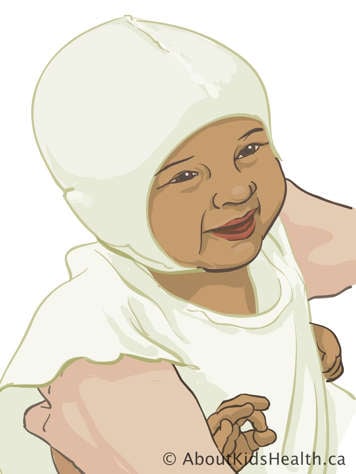What is flat head syndrome (positional plagiocephaly and brachycephaly)?
Positional plagiocephaly (say: play-gee-o-SEFF-ah-lee) is asymmetry in the shape of a baby's skull. Brachycephaly (say: bray-kee-SEFF-ah-lee) is a term used to describe a symmetrical central flattening at the back of the head. Together, these diagnoses describe an abnormal head shape resulting from a preference for one position when a child is lying on their back.

A part of your newborn's skull can become flattened if your baby spends a significant amount of time on their back and prefers to look in one direction. Since they spend so much time sleeping, a baby’s sleep position is the most important contributor to a flat spot. Changing your baby's position often and putting them on their tummy to play several times a day will help prevent your baby from developing a flattened skull. If your child develops flat head syndrome, tummy time and repositioning may be recommended by your physician initially to try to address the flattening. This is effective from birth, up to five to six months of age. A corrective helmet may be recommended if there is no change in your baby's head shape with repositioning or if there is moderate-to-severe skull asymmetry. The ideal time to have a child assessed for helmet therapy is between four and six months of age.
What is a corrective helmet?
A corrective helmet, or CRO, is a custom-made medical device used to address positional flattening of the skull in children. The helmet uses gentle holding pressures to reshape the skull over time as it redirects the head’s growth into the areas that are flat. The helmet does not affect the neurological development of a child.

How long will your child need to wear the helmet?
Your child will likely need to wear the helmet for three to five months or more, depending on your child's rate of growth. It is recommended that your child wear the helmet between 22 and 23 hours per day to achieve optimal correction and prevent the helmet from becoming ill-fitting. Your orthotist will give you specific recommendations based on your child's situation.
Helmet therapy
Initial visit: Assessment and scan
At the first visit, an orthotist will evaluate your baby’s head shape clinically and use 3D scanning technology to capture a 3D model of the head.

In the process of obtaining a scan for your child's helmet, a layer of nylon stockinette will be put on your child’s head with a hole cut for the face and/or ears. The 3D scanner uses a combination of light and cameras to capture the shape; there is no radiation exposure. The scan itself typically takes less than a minute to complete. The digital model of your child’s head will be corrected in order to make your child’s customized helmet.
Second visit: Fitting appointment
This visit will be booked two weeks after the first visit and typically lasts an hour to an hour and a half. At this visit, your orthotis will ensure a proper fit of the helmet, and you will be taught the proper use and care of the device during treatment.
Follow-up visit schedule
You will have a follow-up visit with your orthotist two weeks after the fitting and then every four weeks until the end of treatment. Your child’s head will be examined for shape changes. A 3D scan will be taken every second appointment and will be compared to the previous scan. This helps with tracking your child’s progress. There may be adjustments made to your child’s helmet at these visits.
At SickKids
The Children’s Orthotics Clinic is proud to offer both thermo-molded and 3D-printed orthotic helmets. Your orthotist will discuss the benefits of each and which style may best suit your child and their head shape presentation. A minimum of 50% of the payment for this device is expected at the time of your child’s initial appointment. The remaining 50% of the cost is expected when you receive the helmet. The Children’s Orthotics Clinic is unable to bill your insurance company directly.
Please visit or contact The Children’s Orthotics Clinic for further information on pricing.
All proceeds from orthotic treatment at The Children’s Orthotics Clinic go to support patient care and research at SickKids. For more information, please visit www.sickkids.ca/childrensorthoticsclinic.
Coverage for the corrective helmet
In Ontario, OHIP does not cover any of the cost of the corrective helmet; however, most extended health insurance plans may cover all or a portion depending on your coverage. Speak to your doctor about a prescription and ask your orthotist for an insurance letter to submit to your insurance company for coverage. If you need help to pay for the helmet, visit the reception desk for a list of charitable organizations that may assist you.
